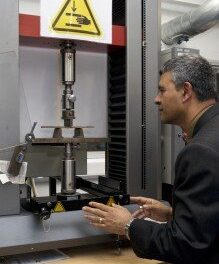LA JOLLA–For decades, astronomers have solved the problem of removing the “twinkle” from images of stars in the night sky. They use a process called “adaptive optics” (AO) to correct for changes in the density and moisture of air in the atmosphere that scatters the incoming star light.
Recently, UC San Diego Professor David Kleinfeld, along with postdoctoral fellow Rui Liu, realized how to adopt this same procedure to correct microscopic images for the scattering of light that occurs in brain tissue. The result of their adaptation was the first-ever recording of the subcellular neuronal inputs and outputs within the cortical mantle—the grey matter forming the cerebral cortex—in mice. Their study is currently published in Nature Methods.
According to Kleinfeld, this novel adaptation is likely to be a fundamental technical advance for the study of computing by nervous systems.
“Thus, as an example, we will be able to visualize how the sensation of touch is transformed into the movement of a limb,” said Kleinfeld, adding that the ability to characterize the input-output relation of circuits is an essential step in the study of any form of computing.
The professor in the UC San Diego Department of Physics and Section of Neurobiology, who is a team leader in the National Institutes of Health’s Brain Research through Advancing Innovative Neurotechnologies (BRAIN) Initiative, explained that the cortex is organized in terms of input, intermediate and output stages. The intermediate stage is on the surface of the cortex, making it most accessible, while the input stage is in the middle and the output stage on the bottom of the cortex—one millimeter deep in mice.
“Past work has focused almost exclusively on the top layer, or intermediate stage, although our UC Berkeley colleague Professor Na Ji used similar methods to probe the input stage,” noted Kleinfeld. “With the recent advance in AO microscopy at UC San Diego, we can now probe all stages—input, intermediate and output—to completely analyze how neuronal signals are transformed within the cortex.”
Other collaborators on the research involved Howard Hughes Medical Institute Investigator Jonathan Marvin and former UC San Diego undergraduate student Zengyi Li.
“It is a wondrous journey to be part of the neurophysics team at UC San Diego. Constructive discussions between Professor Kleinfeld, Zengyi and me are still quite vivid in my mind,” said Liu. “It was also a great opportunity to collaborate with Dr. Marvin, who provided critical help by synthesizing the indicators of neuronal signals. It was the constant guidance and support from my advisor and colleagues that made this project happen.”
The study was supported by a Major Research Instrumentation Award for instrument development from the National Sciences Foundation, as well as a Research Program Award from the National Institutes of Neurological Disease and Stroke. Design and fabrication of the microscope were supported by the National Science Foundation, and physiological measurements were additionally supported by the National Institutes of Health.


